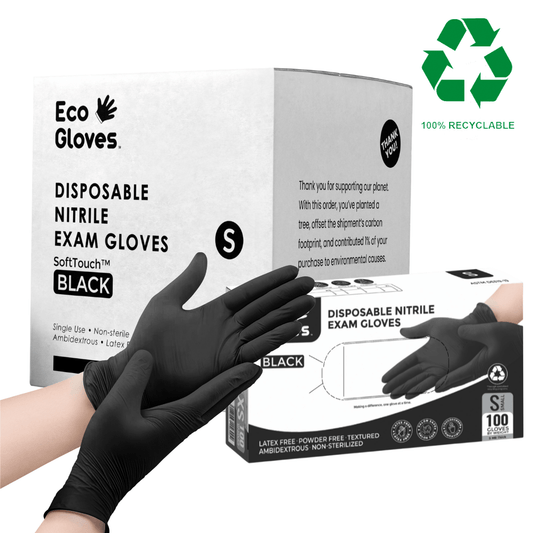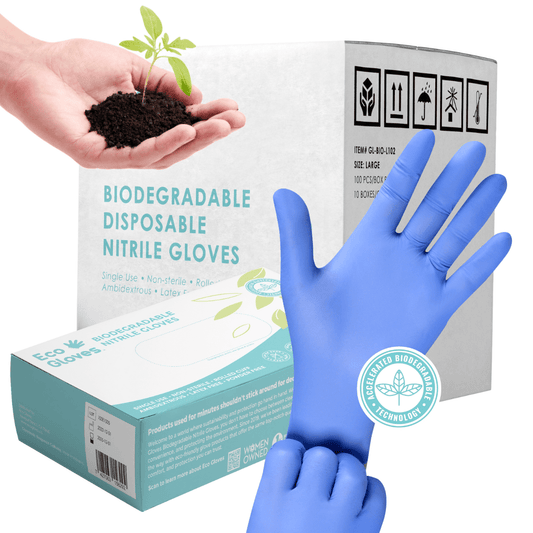Where Are Disposable Gloves Made? Understanding Global Glove Manufacturing (and Why It Matters)
Eco Gloves
Disposable Glove Manufacturing: A Global Perspective
When it comes to choosing the right disposable gloves—whether for medical use, food handling, or industrial applications—many buyers are starting to ask the same question: Where are these gloves made?
With growing interest in domestic production and concerns about import tariffs, supply chains, and sustainability, understanding where and how disposable gloves are manufactured has never been more important. In this article, we break down where disposable gloves are predominantly produced, why the U.S. doesn’t lead in glove manufacturing, and what it all means for your business or personal use.
Where Are Disposable Gloves Made?
The vast majority of disposable gloves—whether latex, nitrile, vinyl, or polyethylene—are produced in Asia. Countries like Malaysia, Thailand, China, and Vietnam dominate the global glove market, each contributing unique advantages to the manufacturing ecosystem.
Malaysia: The Global Leader in Glove Production
Malaysia is often considered the glove manufacturing capital of the world, responsible for over half of the global supply of nitrile and latex gloves. Its dominance is no accident. Malaysia benefits from:
- An abundant supply of natural rubber from local plantations
- Decades of expertise and highly specialized labor
- Established infrastructure and high-capacity factories
- Economies of scale that allow for cost-efficient, high-volume production
Companies based in Malaysia are some of the most trusted names in the glove industry and adhere to stringent international quality standards.
Thailand and Vietnam: Latex and Nitrile Powerhouses
Thailand has long been a leader in latex glove production, thanks to its rich rubber-growing regions and efficient export capabilities. Vietnam, on the other hand, has emerged as a major player in nitrile glove production, benefiting from lower labor costs, government incentives for manufacturers, and rapidly growing investment in modern production technology.
These advantages allow glove manufacturers in Vietnam to remain competitive while producing high-quality disposable gloves for a global market.
China: High Volume and Diversification
While China initially lagged behind in disposable glove production, it has rapidly scaled its output—particularly during the COVID-19 pandemic—to become one of the largest producers of vinyl gloves and an increasing supplier of nitrile gloves.
Chinese manufacturers often excel in bulk production at competitive prices, quick turnaround times, and strong logistics networks for global shipping.
Why Aren’t Disposable Gloves Made in the USA?
Despite growing demand for "Made in USA gloves," domestic glove manufacturing is still extremely limited. There are a few key reasons why most disposable gloves are not produced in the U.S.:
1. High Labor Costs
Manufacturing disposable gloves is labor-intensive, especially during the dipping and quality control processes. U.S. labor costs are significantly higher compared to countries in Southeast Asia, making it difficult for American manufacturers to compete on price.
2. Lack of Raw Materials
One of the biggest challenges facing U.S.-based glove production is the lack of readily available raw materials. Natural rubber, the primary material used in latex gloves, is derived from the sap of rubber trees (Hevea brasiliensis), which are not grown commercially in the United States due to climate limitations. Instead, the world’s supply of natural rubber is concentrated in Southeast Asia, with Thailand, Indonesia, and Malaysia accounting for over 70% of global production. These countries not only cultivate rubber but also operate the infrastructure to process it efficiently into latex compounds, making them the most logical and economical source for latex glove manufacturers.
When it comes to nitrile, the situation isn’t much different. Nitrile gloves are made from nitrile butadiene rubber (NBR), a synthetic compound derived from petroleum. While the base chemicals—such as acrylonitrile and butadiene—are produced globally (including in the U.S.), the processing and polymerization of these chemicals into NBR suitable for glove production is heavily concentrated in countries like China, Malaysia, and South Korea. These regions have invested heavily in the industrial-scale chemical plants and refining capabilities necessary to manufacture NBR at scale and cost-effectively.
Because the U.S. lacks both natural rubber farms and large-scale nitrile processing plants dedicated to glove-grade materials, any domestic glove production would still rely heavily on importing raw or semi-finished materials, driving up costs and logistical complexity. By contrast, established manufacturing hubs in Asia benefit from proximity to raw materials, vertically integrated supply chains, and optimized processing systems, giving them a significant edge in both cost and efficiency.
3. Limited Infrastructure
Unlike Malaysia and Thailand, the U.S. lacks the purpose-built glove manufacturing infrastructure that allows for mass-scale, cost-effective production. Building out this capacity would require massive investments, which many companies are reluctant to make without long-term guarantees of demand.
4. Economies of Scale
Asian manufacturers benefit from decades of producing gloves at high volumes. These efficiencies translate into lower per-unit costs, which are passed down to consumers—something that U.S. producers struggle to match.
The Tariff Dilemma: Why It Still Makes Sense to Import Gloves
With the rise in import tariffs—including recent hikes up to 24% on some types of gloves—some consumers are wondering if buying gloves made in the U.S. might be more advantageous.
In reality, even with tariffs, imported disposable gloves remain the most affordable and reliable option for most users. That’s because:
- The base cost of production overseas is still significantly lower
- Asian factories have the capacity to fulfill large-scale orders quickly
- Quality certifications and global compliance are already well-established
For businesses looking to maintain safety standards without driving up costs, imported gloves continue to be a smart and sustainable choice.
What About Quality and Safety?
It’s a common myth that imported gloves are lower quality. In fact, many overseas manufacturers have higher safety and quality standards than their domestic counterparts.
For example, many gloves produced in Malaysia and Vietnam are:
-
Tested to ASTM and EN standards
-
Produced in ISO-certified facilities
- Compliant with FDA, CE, and other international regulations
At Eco Gloves, we work exclusively with responsible and ethical manufacturers abroad that meet rigorous safety, environmental, and social compliance standards. Learn more on our Sustainability Page.
The Case for Global Glove Production
While supporting American manufacturing is always commendable, it's important to understand the realities of the global glove market. Here’s why buying responsibly sourced imported gloves is still a win:
-
✅ Affordability: Lower production costs keep glove pricing accessible for everyone.
-
✅ Availability: Global supply chains ensure consistency even during high-demand periods.
-
✅ Expertise: Countries like Malaysia have decades of specialized experience.
-
✅ Eco-efficiency: Many manufacturers abroad use biomass fuel, renewable energy, and water recycling systems.
At Eco Gloves, our imported gloves—including biodegradable nitrile gloves and compostable gloves—come from certified, eco-conscious facilities that align with our mission to minimize environmental impact.
Final Thoughts: Buy Smart, Not Just Local
The question of where your disposable gloves are made is a valid one. But the answer isn’t always as simple as “Made in the USA.” Factors like cost, quality, sustainability, and supply chain efficiency matter just as much—if not more.
As the disposable glove industry continues to evolve, embracing global production allows companies like Eco Gloves to offer innovative, affordable, and environmentally responsible gloves that meet your needs—without compromising values or performance.
Further Reading from Eco Gloves
-
The History and Evolution of Disposable Gloves: From Latex to Nitrile
- What Makes Biodegradable Nitrile Gloves More Sustainable or More Eco-Friendly?
- The Ultimate Buyer's Guide to Eco-Friendly Gloves: Selecting the Best Sustainable Disposable Gloves in 2024
- Where to Buy Bulk Nitrile Gloves Without Sacrificing Quality

















